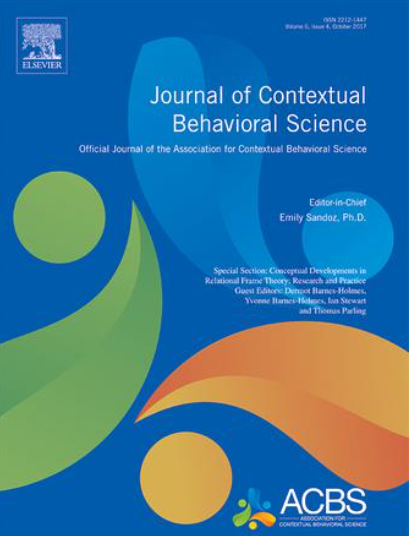Adolescents’ psychological flexibility and non-suicidal self-injury: Exploring between-person and within-person association
IF 3
3区 心理学
Q1 PSYCHOLOGY, CLINICAL
引用次数: 0
Abstract
Most research on the relationship between psychological flexibility and non-suicidal self-injury (NSSI) has been cross-sectional, focusing primarily on specific sub-dimensions of psychological flexibility (e.g., experiential avoidance, cognitive fusion) rather than its integrated constructs. To address these gaps, this study employed the Random Intercept Cross-Lagged Panel Model (RI-CLPM) to investigate the within-person dynamic relationships between psychological flexibility (including six sub-dimensions) and NSSI. A total of 1119 adolescents (mean age = 13.15, SD = 1.26; 50.2 % female) participated in the study, with data collected at six-month intervals over a 1.5 year period. The study revealed that higher psychological flexibility and its six sub-dimensions (i.e., present awareness, acceptance, cognitive defusion, self-as-context, values, and committed action) significantly predicted lower future NSSI over time, while NSSI did not significantly influence psychological flexibility or its sub-dimensions. Moreover, at the between-person level, committed action and cognitive defusion were negatively associated with NSSI. This research is the first to use RI-CLPM to differentiate within-person effects from between-person effects, providing a comprehensive analysis of the dynamic relationship between psychological flexibility (including its sub-dimensions) and NSSI. The findings offer a solid theoretical foundation for future interventions aimed at enhancing psychological flexibility to reduce NSSI among adolescents.
青少年心理弹性与非自杀性自伤:人际关系与人际关系探讨
大多数关于心理灵活性与非自杀性自伤之间关系的研究都是横向的,主要关注心理灵活性的特定子维度(如经验回避、认知融合),而不是其综合构念。为了解决这些差距,本研究采用随机截距交叉滞后面板模型(RI-CLPM)来研究心理灵活性(包括六个子维度)与自伤之间的人内动态关系。共1119名青少年(平均年龄= 13.15,SD = 1.26;(50.2%为女性)参与了这项研究,在1.5年的时间里每隔6个月收集一次数据。研究发现,随着时间的推移,较高的心理灵活性及其六个子维度(即当下意识、接受、认知融合、自我-情境、价值观和承诺行为)显著预测未来较低的自伤行为,而自伤对心理灵活性及其子维度没有显著影响。此外,在人际层面上,承诺行为和认知融合与自伤呈负相关。本研究首次使用RI-CLPM区分人内效应和人间效应,全面分析了心理灵活性(包括其子维度)与自伤之间的动态关系。该研究结果为未来旨在提高心理灵活性以减少青少年自伤的干预措施提供了坚实的理论基础。
本文章由计算机程序翻译,如有差异,请以英文原文为准。
求助全文
约1分钟内获得全文
求助全文
来源期刊

Journal of Contextual Behavioral Science
PSYCHOLOGY, CLINICAL-
CiteScore
8.50
自引率
18.00%
发文量
82
审稿时长
61 days
期刊介绍:
The Journal of Contextual Behavioral Science is the official journal of the Association for Contextual Behavioral Science (ACBS).
Contextual Behavioral Science is a systematic and pragmatic approach to the understanding of behavior, the solution of human problems, and the promotion of human growth and development. Contextual Behavioral Science uses functional principles and theories to analyze and modify action embedded in its historical and situational context. The goal is to predict and influence behavior, with precision, scope, and depth, across all behavioral domains and all levels of analysis, so as to help create a behavioral science that is more adequate to the challenge of the human condition.
 求助内容:
求助内容: 应助结果提醒方式:
应助结果提醒方式:


